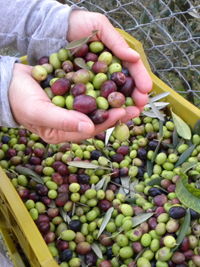 OO is an abbreviated name
for Olive Oil, and in Italy it is a serious business. Italians use only extra virgin paying close
attention to taste, harvest date, producer, and exact location.
OO is an abbreviated name
for Olive Oil, and in Italy it is a serious business. Italians use only extra virgin paying close
attention to taste, harvest date, producer, and exact location.
At Cooking Vacations, we
grow, press and bottle our own with veteran olive oil maker and taster Salvatore.
We produce a high quality extra-virgin olive oil in Campania. The oils are
blends of the more common cultivars (varieties) of this region, like Leccino, Coratina, and
Frantoio. We include the harvest date and added information on the label to
guarantee the best production possible!
Extra-Virgin Olive Oil
The olives used to make our
extra virgin olive oil are healthy and picked just at the right time, making
the oil clean, golden yellow-green in color, and crisp to taste. Our oils
compliment any salad, pasta, risotto, fish and meat too.
Amalfi Coast lemons, sfusato, are gently infused in our extra
virgin olive oil giving it just a hint of lemon. The light tasty oil is great on summer salads, lemon pasta
and risotto, fish and bruschetta.
A Guide to Olive Oil
With so many options on the store shelf, it can be difficult telling which extra virgin olive oil is best. Here are few tips to keep in mind when its time to restock on your liquid gold.
- Look for the when, who, where of your oil: When it was made (harvest date), who made it (producer name), and where it was made it. A quality producer will include this on the label.
- Be sure the label reads, “extra virgin” and not “pure”, “light” oil, or even just “olive oil”- these have gone through chemical adulterations that remove the olives natural flavors and health benefits.
- Olive oil is best if consumed within one year of processing. It can quickly become rancid if not stored properly. Keep your oil in a dark, cool environment and with the cap well sealed. Direct sunlight, heat, and oxygen can contribute to off-flavors.
- Don’t be lured by the dark green color of some oils. Different olive cultivars contribute to various hues and are not an indication of quality.
- Some olive oils are more peppery and pungent while others a more mild and grassy. It just depends on your preference! Try to find a specialty store where you can taste the range of styles for yourself.
- Look for oils that have a “best by” date or better a “harvest date.” The “best by” date is two years from when the oil was bottled not harvested. Unfortunately many oils are stored for years before bottling. Many supermarket olive oils are blends of fresh and older oils that have been chemically altered to remove off aromas.

Visit our Marketplace page where you can purchase our oils online
or come help Salvatore with the harvest in October with our Salvatore Olive Oil Harvest Program!
Source: For more information on the world of olive oil
pick up Tom Mueller’s book, Extra
Virginity. For more tips visit his site, www.extravirginity.com


One of the best information that I really need, a high value of information that may use on my study and research. Thanks for sharing this post.
ReplyDeleteI will share this wonderful blog to Culinary Schools